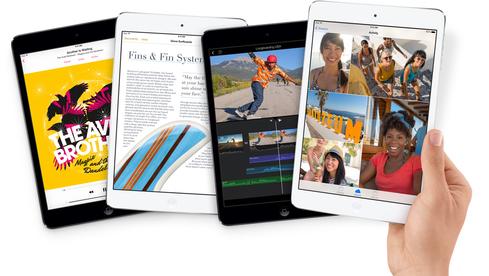Apple's iPads: 4 Things To Watch In 2015
Apple's iPad sales slowed down in 2014, but the company can open new avenues for growth in 2015, especially among enterprise customers.

even a great tablet can't fully eliminate the need for a solid PC. This sort of user sentiment could clearly limit future iPad sales and delay upgrades. Recent Windows 2-in-1s, which have improved markedly from their awkward predecessors, only make the iPad's future harder to predict.
Is Apple merely taking its time before releasing the next great iPad innovation? Or have the devices settled into a new pecking order in which tablets are useful but not as essential and disruptive as once thought? Time will tell -- but here are four ways Apple can -- and in most cases, likely will -- move the iPad needle in 2015.
1. Release a bigger iPad.
This one's been rumored for months. Recent reports are split as to whether the device will boast a 12.2-inch display, or a slightly larger 12.9-inch screen. Either way, the plus-sized iPad -- called the iPad Pro or iPad Air Plus in various reports -- will be much larger than any of the current iOS devices, which top out with the iPad Air's 9.7-inch touchscreen. A new processor will allegedly power the device, which is rumored to include up to 4 GB of RAM and a pixel-rich Retina display. Some reports claim that, despite its larger screen and souped-up internals, the new iPad will be thinner than the original iPad Air -- though not quite as thin as the iPad Air 2, which Apple claims is the world's thinnest tablet. The larger iPad is also expected to contain speakers at both the top and bottom, compared to only a single speaker on current models.
A few of today's larger tablets, such as Microsoft's Surface Pro 3, have sold decently, so Apple might gain customers simply by introducing a larger size, as with the iPhone 6 and 6 Plus. But if the device is to succeed, Apple will need to provide a functional reason for a larger iPad to exist. See the next two items for some of the ways Apple will likely attempt to tackle this requirement.
2. Introduce split-screen multitasking.
Apple hasn't discussed whether future iPads will offer split-screen multitasking, which Windows 8 and 8.1 tablets already offer. Support for the feature was discovered buried in the code of the iOS 8 developers' preview, however -- so it's a good bet Apple will introduce it. The ability to run side-by-side apps would be particularly useful on the rumored iPad Pro, so it won't be surprising if Apple introduces the feature and the tablet together. Will Apple restrict true multitasking to the largest iPad as a differentiating feature? Or will this capability extend all the way down to the iPad Mini? Based on iPad Pro rumors, we should find out some time in the second quarter.
3. Hit the gas pedal on enterprise apps.
During the Steve Jobs era, Apple never showed much interest in accommodating enterprise customers, but as the company's recent pact with IBM demonstrates, things are a bit different under Tim Cook. The partnership's first apps, which integrate with IBM's cloud services, were niche, industry-specific efforts -- not exactly "Siri meets Watson," as InformationWeek's Doug Henschen opined. Future waves of apps will reveal how serious Apple is about pursuing enterprise customers -- but it's a good bet Apple's finally ready to get aggressive. Some reports claim the iPad Pro will be aimed at enterprise customers, for example, which could mean Apple is preparing a host of new apps, perhaps with IBM's help, for the larger screen. Moreover, BYOD programs and corporate deployments of iPads and iPhones have allowed Apple to accrue a huge enterprise user base without expending much focused effort. With Apple's consumer strength spilling into the enterprise, it would be foolish for the company not to take advantage of its newly expanded reach.
4. Invest in new interaction models and use cases.
Whereas the previous three items in this list are relatively likely to occur in 2015, this one is much more speculative. When Tim Cook said the iPad is still ripe for innovation, one hopes he was talking about more than larger screens and a multitasking feature already present in Windows tablets. Based on patents, however, Apple has lots of other ideas, such as iPads that can be controlled, not only via touch screens, but also through gestures. Other iPad patents refer to solar-charged devices and attachable keyboards like those many Windows tablets offer. Voice controls are another area for potential improvement. Siri has evolved over time, but many of us are still waiting for the digital assistant to take a truly transformative leap.
Attend Interop Las Vegas, the leading independent technology conference and expo series designed to inspire, inform, and connect the world's IT community. In 2015, look for all new programs, networking opportunities, and classes that will help you set your organization’s IT action plan. It happens April 27 to May 1. Register with Discount Code MPOIWK for $200 off Total Access & Conference Passes.
About the Author(s)
You May Also Like







